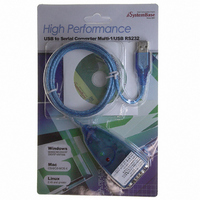20-151-0178 Rabbit Semiconductor, 20-151-0178 Datasheet - Page 74

20-151-0178
Manufacturer Part Number
20-151-0178
Description
CABLE CONVERTER RS-232 TO USB
Manufacturer
Rabbit Semiconductor
Datasheet
1.20-151-0178.pdf
(162 pages)
Specifications of 20-151-0178
Accessory Type
USB to RS232 Adapter
Product
Microcontroller Accessories
For Use With/related Products
Rabbit-based Boards
Lead Free Status / RoHS Status
Lead free / RoHS Compliant
Other names
20-151-0178
316-1181
316-1181
- Current page: 74 of 162
- Download datasheet (4Mb)
connector/pin assignments. The .xml file is more important. It is used when you want to reorder a particu-
lar design. A board design cannot be ordered without its .xml file. Although your design file may still be
available through your RabbitFLEX account, it is your responsibility to maintain a copy of the design
.xml file.
6.3 RabbitFLEX BL300F Software Concepts
There are several concepts that must be understood to program the RabbitFLEX BL300F. This section will
describe these concepts.
6.3.1 Board Initialization
To use much of your RabbitFLEX BL300F I/O functionality, you must first call the brdInit() func-
tion. This must be called before you call any other RabbitFLEX functions.
6.3.2 Software Pin Names
Because the RabbitFLEX BL300F has many configurable I/O pins, we need some mechanism for referring
to these pins within the software. To accomplish this, each of the pins can be given a software name at
design time (within the RabbitFLEX Configurator). All software names will begin with “flex_”. This soft-
ware name is actually the name of a C data structure that represents all information that the system needs
to know about that particular I/O pin. Note that each pin will be given a software name whether you pro-
vide one or not—your design summary file will display your software names.
Many RabbitFLEX functions accept a Flex_IOPin* as the first parameter. For example, look at the
prototype declaration for the flexDigIn() function:
So, if you have a digital output with a software name of “flex_led1”, then this will correspond to a
Flex_IOPin data structure named “flex_led1”. To change the state of this digital output, you might do
the following:
Note that you must precede the software name with an ‘&’ character—this passes a pointer to the data
structure to the flexDigOut() function. More explanation of software names and how to use them is
given in the software walk-through section later in this chapter.
The LCD, keypad, and speaker also have software names, but they are predefined and not changeable by
the user. These devices, if they exist on your RabbitFLEX BL300F design, must be referenced as follows:
So, to get a keypress from your keypad, you would do the following:
68
int flexDigOut(Flex_IOPin *pin, int state);
flexDigOut(&flex_led1, 1);
ch = flexKeyGet(&flex_keypad);
LCD
Keypad
Speaker
Device
www.rabbit.com
flex_lcd
flex_keypad
flex_speaker
Software Name
Applications Programming
Related parts for 20-151-0178
Image
Part Number
Description
Manufacturer
Datasheet
Request
R

Part Number:
Description:
Microcontroller Modules & Accessories Assy Download 1.27MM and 2MM Pitch Cbles
Manufacturer:
Rabbit Semiconductor

Part Number:
Description:
Trimmer Resistors - Multi Turn 20Kohms 5% 1 1/4 PC Mount
Manufacturer:
Bourns Inc.
Datasheet:
Part Number:
Description:
LCD Drivers 160 SEGMENT LCD SEGMENT DRIVER
Manufacturer:
NXP Semiconductors

Part Number:
Description:
20-24 awg TIN PIN REEL M-N-L
Manufacturer:
TE Connectivity
Datasheet:
Part Number:
Description:
IC REAL TIME CLK/CALENDAR 20SOIC
Manufacturer:
NXP Semiconductors
Datasheet:
Part Number:
Description:
IC REAL TIME CLK/CALENDAR 20SOIC
Manufacturer:
NXP Semiconductors
Datasheet:
Part Number:
Description:
IC RTC/CALENDAR TCXO QTZ 20SOIC
Manufacturer:
NXP Semiconductors
Datasheet:
Part Number:
Description:
Manufacturer:
ON Semiconductor
Datasheet:

Part Number:
Description:
20-OUTPUT LVTTL CLOCK DRIVER
Manufacturer:
AMCC (Applied Micro Circuits Corp)

Part Number:
Description:
20-OUTPUT LVTTL CLOCK DRIVER
Manufacturer:
AMCC (Applied Micro Circuits Corp)

Part Number:
Description:
20-OUTPUT CLOCK DRIVER
Manufacturer:
AMCC (Applied Micro Circuits Corp)












